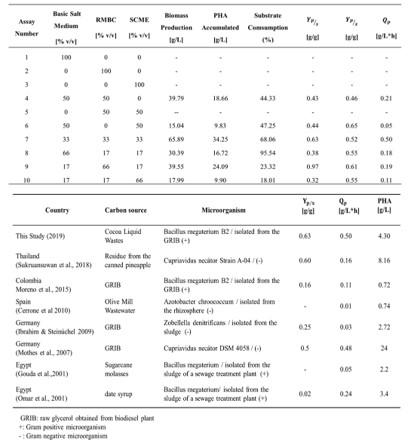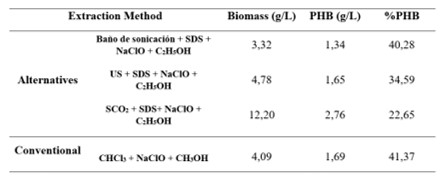Autores
Quintero-silva, M. (VICERRECTORÍA DE INVESTIGACIÓN Y EXTENSIÓN, UIS) ; Suárez-rodríguez, S. (ESCUELA DE INGENIERÍA QUÍMICA, UIS) ; Gamboa-suárez, M. (ESCUELA DE QUÍMICA, UIS) ; Blanco-tirado, C. (ESCUELA DE QUÍMICA, UIS) ; Combariza, M. (ESCUELA DE QUÍMICA, UIS)
Resumo
Cacao mucilage exudates (CMEs) are byproducts of cacao beans fermentation. CMEs
were used as substrate for polyhydroxyalkanoates (PHAs) production. PHAs are
potential biopolymers to replace plastics conventional, these are synthesized by
many microorganisms intracellularly. Processes that involve chlorinated solvents
are commonly used for PHAs extraction. This study follows the adaptation process
of microorganism to the CMEs-based media and the influence of variables in PHAs
production. Additionally, evaluation of alternative extraction methods to replace
the traditionally used chlorinated solvents. A product yield of 0.63g/g, with an
accumulation of 34% was obtained. Regarding the extraction methods evaluated, a
purity of 99% and a yield of 40.28% was obtained using an alternative method.
Palavras chaves
Polyhydroxyalkanoates; cacao mucilage exudate; native strain
Introdução
Increasing material´s circularity in agroindustrial crops is of fundamental
importance for a low-carbon economy. We are interested in improving Colombia´s
cacao production circularity by increasing biomass usage. Processing the whole
cacao fruit is a strategy that allows access to residual biomass, such as cacao
mucilage exudate (CME), to produce advanced materials. Liquid cacao fruit wastes
(CLWs) result from biotechnological applications of CME. For instance, spent
cacao mucilage exudate (SCME) originates from cacao beans fermentation. At the
same time, from biocellulose synthesis, we obtain residual media from bacterial
cellulose production (RMBC). SCME and RMBC are effluents rich in sugars and low
molecular weight organic acids.
In this work, we report using CLW to formulate various culture media for
polyhydroxyalkanoates (PHAs) biosynthesis using a native Bacillus megaterium
strain (B2). PHAs have thermoplastic and elastomeric properties like those of
conventional synthetic polymers from petrochemical sources (REIS et al., 2008).
Bacillus megaterium B2 accumulates intracellular PHA inclusions as carbon and
energy reserves (MUTIARA et al., 2014). For extraction PHAs processes
chlorinated solvents are commonly used (YUSTINAH et al., 2019). Therefore, an
alternative of extraction method will reduce the environmental impact of these.
Chemical agents (SDS, NaClO and C2H5OH), mechanical disruption (ultrasound) and
supercritical CO2 treatment were evaluated for the extraction methods.
Characterization using MALDI-TOF-MS, FTIR and UV-vis spectroscopy, elemental
composition, and thermal analysis confirmed the presence of a bioplastic of the
polyhydroxybutyrate (PHB) type.
Material e métodos
We follow the adaptation process of B2 to the CLW-based media. Once adapted, the
strain was transferred to a 7.5-liter batch bioreactor with an initial working
volume of 4 L at 34°C, pH 7, oxygenation of 1L/min of air and agitation at 400
rpm, to assess the influence of operational variables in PHAs production, yield,
productivity, and microorganism kinetics. Culture medium CME-based substrates
with SCME/RMBC Mixing ratios by different levels of these were evaluated, as
seen in table 1. Once again, biomass production, as dry cell weight (DCW), and
PHA production and substrate consumption, determined via HPLC measurements, were
the measurable variables monitored during the bioprocess. All tests were
performed in triplicate.
The extraction was carried out in two stages, the first was cell lysis and in
the second the PHB was separated from the residual mass. For the cell disruption
process, ultrasound and supercritical carbon dioxide techniques were evaluated.
When the cell membrane was destroyed, the PHB was purified. The non-PHB cell
mass solubilization approach was chosen, mainly using oxidizing agents such as
sodium hypochlorite and hydrogen peroxide due to their characteristics, such as
their strong oxidizing properties and their non-selectivity, in addition, sodium
hypochlorite and hydrogen peroxide are not volatile and their cost is relatively
low. In addition, sodium dodecyl sulfate (SDS) and ethanol were used to remove
low molecular weight lipids. The obtained biopolymer was characterized by MALDI-
TOF, FTIR, TGA, DSC and elemental analysis. Finally, the results obtained were
compared with the PHB standard and with the polymer extracted with the standard
method normally used in the literature, which is the one that uses chlorinated
solvents such as chloroform.
Resultado e discussão
Table 1 show the results for PHB production assays. The product yield was 0.63 g
/ g, with an accumulation percentage of 34% and a productivity increase of 33%
compared to other works using the same microorganism as can see table 2.
In the ecological processing for the recovery of PHB from biomass, supercritical
CO2 or ultrasound was used for cell disruption and chemical agents to solubilize
the non-PHB material. in the results, a purity of 98.32% and a yield of 41.3%
were obtained in the extraction using chlorinated solvents. However, the
alternative method where the sonication bath was used as the cell lysis
technique and SDS, sodium hypochlorite and ethanol as solvents presented a PHB
yield of 40.28% and a purity of 99. 58 %, being very close values in both tests.
In the infrared spectrum, the disappearance of the 1647 and 1543 cm-1 signals
corresponding to the N-H bending was identified, due to impurities due to
cellular debris, which was corroborated by the decrease in %N in the elemental
analysis. TGA and MALDI-TOF confirmed its identity as polyhydroxybutyrate as can
see figure 1. Physicochemical and spectroscopic properties of PHB are like those
of standard PHB and PHB extracted with chlorinated solvents. The results of this
work are positive for the reduction of costs and environmental impacts.

Results obtained and overview of literature describing production of PHAs from different microorganisms and different substrate.

Conclusões
Bacillus species were able to efficiently consume and bioconvert cocoa mucilage to
PHB. The highest product yield was 0.63 g/g, with an accumulation of 34%. In the
ecological processing for the recovery of PHB from biomass, the most promising
method was used sonication bath as the cell lysis technique and SDS, sodium
hypochlorite and ethanol as solvents presented a PHB yield of 40.28% and a purity
of 99.58%. Additionally, the identity of the PHB obtained and its similarity in
terms of physicochemical properties with the standard PHB and PHB extracted with
chlorinated solvents is confirmed.
Agradecimentos
The authors would like to thank the Universidad Industrial de Santander and
Ministerio de Ciencia Tecnología e Innovación for the economic support provided.
We are grateful to the CEIAM group for technical and academic support.
Referências
Cerrone, F., del Mar Sánchez-Peinado, M., Juárez-Jimenez, B., González-López, J., & Pozo, C. Biological treatment of two-phase olive mill wastewater (TPOMW, alpeorujo): Polyhydroxyalkanoates (PHAs) production by azotobacter strains. Journal of Microbiology and Biotechnology 2010, 20(3), 594–601.
Gouda, M. K., Swellam, A. E., & Omar, S. H. Production of PHB by a Bacillus megaterium strain using sugarcane molasses and corn steep liquor as sole carbon and nitrogen sources. Microbiological Research 2001, 156(3), 201–207.
Ibrahim, M. H. A., & Steinbüchel, A. Poly(3-hydroxybutyrate) production from glycerol by Zobellella denitrificans MW1 via high-cell-density fed-batch fermentation and simplified solvent extraction. Applied and Environmental Microbiology 2009, 75(19), 6222–6231.
Moreno, P., Yañez, C., Cardozo, N. S. M., Escalante, H., Combariza, M. Y., & Guzman, C. Influence of nutritional and physicochemical variables on PHB production from raw glycerol obtained from a Colombian biodiesel plant by a wild-type Bacillus megaterium strain. New Biotechnology, 2015, 32(6), 682–689.
Mutiara, I.; Razaad, N.; Li, Y.; Zhao, L.; Mo, Y.; Wang, J. Start a Research on Biopolymer Polyhydroxyalkanoate (PHA): A Review. Polymers. 2014, 6, 706–754.
Omar, S., Rayes, A., Eqaab, A., Voß, I., & Steinbüchel, A. Optimization of cell growth and poly(3-hydroxybutyrate) accumulation on date syrup by a Bacillus megaterium strain. Biotechnology Letters 2001, 23(14), 1119–1123.
Reis, K. C., Pereira, J., Smith, A. C., Carvalho, C. W. P., Wellner, N., & Yakimets, I. Characterization of polyhydroxybutyrate-hydroxyvalerate (PHB-HV)/maize starch blend films. Journal of Food Engineering, 2008, 89(4), 361–369.
Sukruansuwan, V., Napathorn, S.C. Use of agro-industrial residue from the canned pineapple industry for polyhydroxybutyrate production by Cupriavidus necator strain A-04. Biotechnol Biofuels 2018, 11, 202.
Yustinah; Hidayat, N.; Alamsyah, R.; Roslan, A. M.; Hermansyah, H.; Gozan, M. Production of Polyhydroxybutyrate from Oil Palm Empty Fruit Bunch (OPEFB) Hydrolysates by Bacillus Cereus Suaeda B-001. Biocatal. Agric. Biotechnol. 2019, 18, 101019.
















